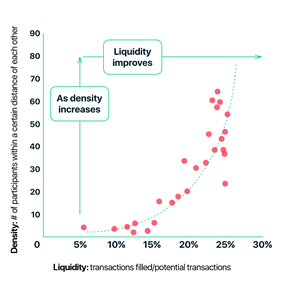The Hookup Doctor's Guide
Navigating the world of modern dating and relationships.
Marketplace Liquidity Models: Where Fish Meet Bargains
Dive into the intriguing world of marketplace liquidity models and discover how fish meet bargains in innovative ways! Uncover hidden gems now!
Understanding Marketplace Liquidity Models: A Deep Dive into Harmonizing Supply and Demand
In the realm of e-commerce and finance, marketplace liquidity models serve as crucial frameworks for balancing supply and demand. Understanding these models involves assessing various factors that contribute to the ease with which assets can be bought or sold in a marketplace without causing significant price changes. By examining the intricacies of both the buyer's and seller's sides, stakeholders can better identify the points of friction that may lead to inefficiencies. Effective marketplace liquidity not only enhances transaction speed but also improves market confidence, which ultimately contributes to a healthier trading environment.
One influential approach to achieving optimal liquidity is the implementation of dynamic pricing strategies that adapt to real-time supply and demand fluctuations. Such models often rely on algorithms and data analysis to forecast trends, allowing stakeholders to respond rapidly to changing market conditions. Enhancing transparency is also pivotal; clear information regarding inventory levels and pricing can significantly influence buyer decisions. In essence, by harmonizing supply and demand through effective liquidity models, marketplaces can ensure sustainable growth and increased participant satisfaction.

Counter-Strike is a highly popular first-person shooter game that emphasizes teamwork and strategy. Players can participate in various game modes, including bomb defusal and hostage rescue, where they must work together to achieve their objectives. If you're looking to enhance your gaming experience, you might want to check out a daddyskins promo code for great in-game skin deals!
How Do Liquidity Models Drive Value in Marketplaces? Exploring Key Concepts
Liquidity models play a crucial role in determining how effectively a marketplace functions, influencing both supply and demand dynamics. By providing a framework to evaluate the flow of assets, liquidity models help marketplace participants understand the ease of buying and selling goods or services. For instance, the liquidity of a market directly impacts the availability of options for consumers, which in turn affects overall market value. When liquidity is high, transactions occur more frequently, and price stability improves, leading to a more vibrant and engaging marketplace.
Moreover, understanding liquidity models assists businesses in creating strategies that maximize their operations within these environments. Factors such as buyer-seller ratios, transaction speed, and market depth are essential to consider. Liquidity acts not only as a metric of health for a marketplace but also serves as a predictive tool for future performance. By leveraging insights from liquidity models, stakeholders can optimize their offerings and enhance user experience, ultimately driving greater value in the marketplace ecosystem.
What Makes Fish Meet Bargains? The Role of Market Dynamics in Marketplace Liquidity
Understanding market dynamics is crucial when exploring the reasons behind the attractive pricing of fish meat in various marketplaces. Several factors contribute to these bargains, including supply and demand fluctuations, seasonal availability, and consumer preferences. For instance, during the peak fishing season, an abundance of catch causes a significant decrease in prices, as vendors aim to sell their stock quickly. Additionally, the influence of market liquidity plays a pivotal role, wherein the ease of buying and selling fish meat directly affects its pricing. When buyers have greater access to diverse fish products, the competition among sellers intensifies, often leading to attractive deals and discounts for consumers.
Moreover, technological advancements and online marketplaces have revolutionized how fish meat is bought and sold. The introduction of e-commerce platforms has eliminated geographical barriers, enabling small-scale fishmongers and larger distributors to reach a wider audience. This increased competition fosters a thriving marketplace where liquidity is high, and sellers are motivated to price their products competitively to entice buyers. Also, market trends indicate that as awareness grows regarding sustainable fishing practices, suppliers are more likely to offer deals on responsibly sourced fish, further contributing to the availability of bargains for conscious consumers. Ultimately, the interplay of these market dynamics and consumer behavior underscores the continuous fluctuation of prices and the quest for value in fish meat purchases.